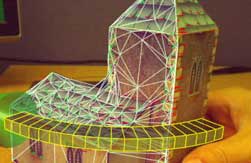A group of researchers at the Department of Engineering at Cambridge University have created a program that is able to build 3D models of textured objects in real time, using only a standard computer and webcam.
The development is expected to aid in the creation of virtual 3D models, a process that often requires heavy and expensive equipment, or is time consuming.
Qi Pan, Dr Gerhard Reitmayr and Dr Tom Drummond presented the system at the 20th British Machine Vision Conference in London.
During the last few years, many methods have been developed to build a realistic 3D model of a real object, using equipment including 2D/3D lasers, scanners, projectors and cameras.
These pieces of equipment are usually expensive, complicated to use or inconvenient and the model is not built in real time. The data (for example, laser information or photos) must first be acquired, before going through a lengthy reconstruction process to form the model. If the 3D reconstruction is unsatisfactory, then the data must be acquired again.
In the method proposed by Qi and his colleagues, an object is moved about in front of a webcam and software can reconstruct the object while collecting live video. The system uses points detected on the object to estimate object structure from the motion of the camera or the object, and then computes the Delaunay tetrahedralisation of the points. The points are recorded in a mesh of tetrahedra, within which is embedded the surface mesh of the object.

The software then tidies up the final reconstruction by taking out the invalid tetrahedra to obtain the surface mesh based on a probabilistic carving algorithm, and the object texture is applied to the 3D mesh in order to obtain a realistic model.
The researchers claim that, thanks to the simple and cheap system, 3D reconstruction will become accessible to everybody.




IEA report claims batteries are ‘changing the game’
The weight and bulk of static batteries, even domestic units, is immaterial. The IEA's trilemma is illustrated here:-...